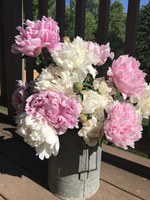Dakota Gardener: Perfect peonies
(Click an image below to view a high-resolution image that can be downloaded)
By Carrie Knutson, horticulture agent
NDSU Extension - Grand Forks County
Peonies are one of my favorite spring flowers. I have four plants and I can’t wait until my house is filled with pink and white peony blossoms. If you don’t have them in your landscape, I encourage you to find space to grow a peony.
Peonies are herbaceous perennials that grow 3 to 4 feet tall and wide. Peonies can grow for many years and are often found still growing around old houses and in old cemeteries.
There is a common shrub form of the peony, mentioned above, as well as tree forms and a combination of the two forms. There are many different bloom colors, including reds, pinks, white and pink, corals and even yellow.
Peonies require full sun and will not do well in shade. Most of the time, they will do well without any additional care if they receive enough sun. If you choose to fertilize your plant, wait until after it has bloomed as excess nitrogen could reduce the number of blooms.
Peonies are a great cut flower. I like to harvest the blooms in the morning. Blooms should be just barely open at harvest time. When you gently squeeze the bud, it should feel like a marshmallow. The soft, yet closed buds make it easier to wash any insects off with water before you bring them inside.
A side note on ants and peonies: peony blooms don’t need ants to open. However, ants enjoy the sweet secretion produced by the buds as they grow.
To extend the harvest and your enjoyment, peonies can be harvested and stored in the fridge. Simply store the marshmallow buds in the fridge. Wrap them in plastic wrap with the cut ends in water. Then, bring them out of the fridge when you want some blooms to brighten your day.
If you don’t bring the flowers inside, the spent blooms should be removed from the plant to keep it from breaking. Remove the spent flowers where a leaf is attached to the stem.
The most common disease I see on peonies is powdery mildew. There are other diseases such as, Peony leaf blotch and botrytis blight. The best way to fight these diseases is good garden sanitation and to reduce the time leaves stay wet by making sure there is air movement.
If your plants have not been blooming as much or if disease has been an issue, division might help. Division is splitting of a plant into smaller pieces to help the plant to improve growth. Peonies don’t like to be moved or divided so they can take 2 to 3 years to recover. If you need to move or divide plants, wait until the fall. When planting peonies the top of the roots should be placed 1 to 2 inches deep in the soil.
Have you found space for a peony yet? Happy gardening!
NDSU Agriculture Communication – June 13, 2023
Source: Carrie Knutson, 701-780-8229, carrie.knutson@ndsu.edu
Editor: Kelli Anderson, 701-231-6136, kelli.c.anderson@ndsu.edu




